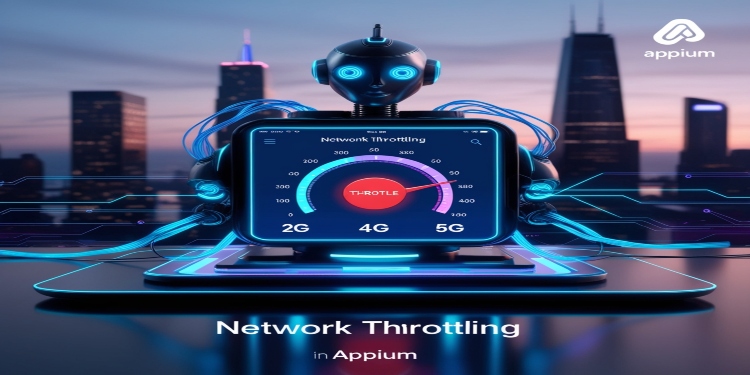Network throttling is the process of managing internet speed to test apps under various environments. Developers use network throttling to test app performance when the network is slow or stable. Android automation frameworks such as Appium make it even more simpler.
Appium is an automation tool for testing mobile apps automatically. With Appium, testing can be performed even for applications running under varied network speeds, i.e., 2G, 3G, or LTE. It is useful in order to provide applications that could perform well-performing to the user over various internet connections.
Testing the app with a slow or even fast internet connection aids in early detection of bugs. It keeps the app smooth even when the network is poor.
Understanding Network Throttling
Throttling on a network means slowing down the internet speed voluntarily. Internet Service Providers (ISPs) slow it down so that they may manage traffic and offer equal service to everyone.
Throttling prevents network overload, particularly when numerous people are online at peak times. By slowing down, ISPs provide smooth operation of the web for everyone. There are many instances where network throttling is helpful. For example, ISPs can reduce the speed of some users during peak hours to prevent overloading.
Network throttling is also employed by developers to check whether their app functions properly under variable circumstances. Through emulating poor speeds, such as 2G or 3G, they can determine whether their app performs well even when the internet is not good. This is necessary since most users will have poor or unreliable connections.
There are various tools and techniques for network throttling. Browser development tools, such as those in Chrome or Firefox, permit developers to limit a certain speed when testing websites. There are also software applications that are meant for network simulation, which can generate several types of network conditions. These aids enable developers to make their apps reliable and user-friendly, irrespective of the speed of the internet connection of the user.
Through an understanding and implementation of network throttling, app developers can enhance application performance and ensure a good experience for all users.
Appium and Network Throttling Basics
Appium is a potent tool aimed at automating the testing of mobile applications. It has a vital feature in terms of simulating various network conditions, something necessary for testing app performance across diverse internet speeds.
With Appium, developers can simply configure network throttling parameters so that they can simulate conditions such as 2G, 3G, or even slower. This feature ensures that apps are stable and can withstand real-world situations where users might not have high-speed internet access.
Testing apps on various internet speeds is important for a number of reasons. First, most users globally continue to use slower internet speeds, particularly in rural or developing areas. If an app only works well under fast internet speeds, it can annoy users with slower speeds.
Through the use of Appium to test such situations, developers can catch potential problems and enhance the user experience for all. This is a preventive measure that avoids bad reviews and enhances user satisfaction.
In the case of testing, a critical difference is to be observed between actual devices and emulators. Emulators are computer-run simulations of mobile devices using software. They are less expensive in many cases and permit rapid cycles of testing.
Yet they could be less accurate when it comes to simulating the way an application will operate on an actual device because hardware and network patterns will differ. Conversely, testing on actual devices presents a better representation of how the app will run in real-life situations, but may be more time and money-consuming. Both practices are advantageous as well as disadvantageous, but they can together result in proper testing and improved app quality as a whole.
Methods to Implement Network Throttling in Appium
The following are the methods to implement network throttling in Appium:
- Applying Desired Capabilities
Appium supports simulation of various network conditions on Android emulators through the networkSpeed desired capability. This capability comes in handy when testing the performance of apps over different internet speeds such as GSM, LTE, or 3G. With this capability set, you can easily verify whether your app performs well under slow network conditions.
In order to use networkSpeed, you must include it in your setup when beginning your tests. Suppose you are trying to test for a 2G connection; you would declare that in your test configuration. This works very well with emulators and serves to pick up performance problems early. It also makes your app deliver a good experience even during bad networks.
- Using Proxy Tools
For actual devices, it is possible to use proxy tools such as Toxiproxy to apply network throttling. Toxiproxy enables you to dictate network conditions by means of its API and hence can be used to test apps in various situations such as high latency or limited bandwidth. It provides you with the ability to establish a proxy between your device and the Appium server.
With Toxiproxy, you can configure different network conditions dynamically. That is, you can mimic different internet connection types when testing your app. While this approach is more involved compared to using networkSpeed, it is effective for both emulators and real devices, providing you with greater control over the testing environment.
- Applying Network Conditions
Appium also has support for dynamic network throttling using the networkConditions capability. You can utilize predefined profiles such as “2G” or “4G-fast” to conveniently simulate particular speeds. This simplifies testing the way your application reacts under varied network conditions.
Apart from beginning with a pre-defined profile, you can modify network conditions during testing. This gives you the ability to test several scenarios in one session. It is particularly helpful for applications that must respond to changing network speeds. By using these techniques together, developers can make their applications run well regardless of the type of internet connection users have.
Cloud Testing’s Integration for Network Throttling
Cloud platforms simplifies network throttling for Appium tests. LambdaTest is one such platform that testers can easily leverage to test different internet speeds, even offline, through predefined or custom profiles. This ensures apps are tested in real conditions, increasing their reliability and user experience.
Using LambdaTest, you can also configure the networkProfile capability to emulate particular network environments such as 2G or 3G. In the course of testing, profiles may also be dynamically switched in order to test the behavior of apps under changing network conditions. For instance, the testers can begin with a slow 2G network and then switch to a faster 4G environment within the same session.
LambdaTest also provides offline mode, in which applications are tested without an internet connection. Custom profiles can also be established by specifying parameters such as download speed, upload speed, and latency. This gives it the capability to become a powerful tool for app performance assurance under different conditions. These are especially handy when testing on an Android emulator Mac since they mimic real-world conditions quite well.
Controlling Latency with Emulator Arguments
Appium can introduce latency on emulators through emulator arguments such as -netdelay. Through this argument, testers can mimic network delays and learn how apps react to slow or delayed connections.
In order to set up latency, testers add the -netdelay argument when they are establishing their emulator. For instance, they can introduce a delay of 100 milliseconds to mimic a slightly slower network. This allows them to detect any issues that may occur because of network lag.
Latency levels can also be dynamically set while testing by simply restarting the emulator with new arguments. For instance, testers may raise the 100-millisecond delay to 200 milliseconds halfway through a test to see how the application behaves under deteriorating conditions. The technique works most effectively when using emulators for testing apps, but might not necessarily work with actual devices.
With emulator options such as -netdelay, applications are strong and resilient against real-world network issues. Utilizing this practice in tandem with cloud platforms like LambdaTest supports end-to-end testing across both emulators and actual devices for high-quality performance of apps across all users.
Challenges and Solutions of Network Throttling in Appium
Network throttling tests often face issues such as device performance variability and incorrect capability values. For example, emulators may behave differently from real devices, leading to inconsistent results. Additionally, setting up capabilities incorrectly can cause tests to fail or produce unreliable data.
To have correct results in simulation, testers must check all the configurations prior to test execution. Through the use of pre-existing profiles such as “2G” or “3G,” consistency in tests is ensured. Testing both on emulators and actual devices is also vital to detect variances in app performance.
After running tests, resetting settings is important to prevent interference in subsequent sessions. This provides clean testing environments and eliminates residual effects of earlier network settings. Implementing these practices enhances the consistency of network throttling tests and guarantees comprehensive app testing.
Future of Network Throttling in Appium
The future of network throttling in Appium is bright, with innovations targeted at more effective simulation and integration for actual-world testing. LambdaTest is already facilitating testers to mimic varied network conditions, ranging from changing load and offline conditions, through custom profile support. This supports developers in making their applications reliable across different environments.
For actual devices, tools such as Toxiproxy are leading the way to greater control over network environments through APIs. Using this method, test cases can dynamically simulate latency, bandwidth caps, and jitter, providing accurate results. Coupled with emulators that accommodate native network throttling tools, the testing scenario grows more flexible.
As Appium matures, we can anticipate tighter integration with cloud platforms and increased support for real devices. Such improvements will enable easier testing and make it more accessible, pushing developers to apply these methods on a large scale in their workflows.
Conclusion
To conclude, simulating varying internet speeds during Appium tests is critical to ensure that applications work well in various network scenarios. Through the application of methods such as network throttling, custom profiles, and dynamic configurations, developers can detect potential problems early and improve UX.
These approaches cause applications to react and are accessible no matter the user’s internet speed. Developers can incorporate these practices into their testing processes to enhance the quality and performance of their applications, as well as the satisfaction and success of the end users in the competitive application world.











































































